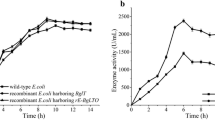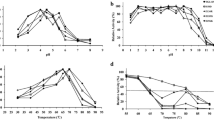Abstract
β-glucanases are widely applied in biological control, brewing and feed industries; however, there are seldom studies of β-glucanases in probiotics. Here, β-glucanase genes were cloned from Bacillus licheniformis, Lactobacillus fermentum and L. johnsonii. β-glucanase genes, as blg, lfg and ljg isolated from B. licheniformis, L. fermentum and L. johnsonii were prokaryotic expressed to obtain recombinant strains BL, LF and LJ, respectively. Directed mutations in these genes were introduced by sequential error-prone PCR. Results showed that β-glucanase activities in three mutants mblg, mlfg and mljg were 1.94-, 2.72- and 1.29-fold higher than the BL, LF and LJ, respectively. Mutation sites analysis showed substitutions at Ser370Gly and Leu395Phe in mblg; Arg169His and Asn302Ser in mlfg; Val132Met, Ser226Asn, and Asp355Gly in mljg. Spatial structural predictions revealed the numbers and positions of α-helices and β-strands in the three mutants were altered, which might result in β-glucanase activity increasement. Analysis of β-glucanase properties revealed no significant differences in the optimal temperatures and pH between mutant and wild-type strains. However, mlfg and mljg exhibited greater thermal stability at 30–50 ℃ than the wild-type strains, and mblg improved pH stability compared with wild-type strain. This is the first report about β-glucanase-encoding genes in L. fermentum and L. johnsonii. These findings provide an efficient way to improve the activity of β-glucanase.




Similar content being viewed by others
References
Abel M, Iversen K, Planas A, Christensen U (2003) Pre-steady-state kinetics of Bacillus licheniformis 1,3–1,4-beta-glucanase: evidence for a regulatory binding site. Biochem J 371:997–1003
Arowolo MA, He J (2018) Use of probiotics and botanical extracts to improve ruminant production in the tropics: a review. Anim Nutr 4:241–249
Balci H, Ozturk MT, Pijning T, Ozturk SI, Gumusel F (2014) Improved activity and pH stability of E. coli ATCC 11105 penicillin acylase by error-prone PCR. Appl Microbiol Biotechnol 98:4467–4477
Bjellqvist B, Basse B, Olsen E, Celis JE (1994) Reference points for comparisons of two-dimensional maps of proteins from different human cell types defined in a pH scale where isoelectric points correlate with polypeptide compositions. Electrophoresis 15:529–539
Cao GT, Dai B, Wang KL, Yan Y, Xu YL, Wang YX, Yang CM (2019) Bacillus licheniformis, a potential probiotic, inhibits obesity by modulating colonic microflora in C57BL/6J mice model. J Appl Microbiol 127:880–888
Celestino KR, Cunha RB, Felix CR (2006) Characterization of a beta-glucanase produced by Rhizopus microsporus var. microsporus, and its potential for application in the brewing industry. BMC Biochemi 7:23
Chatterton S, Punja ZK (2009) Chitinase and beta-1,3-glucanase enzyme production by the mycoparasite Clonostachys rosea f. catenulata against fungal plant pathogens. Can J Microbiol 55:356–367
Chinabut S, Puttinaowarat S (2005) The choice of disease control strategies to secure international market access for aquaculture products. Dev Biol 121:255–261
Choct M (2006) Enzymes for the feed industry: past, present and future. Worlds Poult Sci J 62:5–15
Davoren MJ, Liu J, Castellanos J, Rodríguez-Malavé NI, Schiestl RH (2019) A novel probiotic, Lactobacillus johnsonii 456, resists acid and can persist in the human gut beyond the initial ingestion period. Gut Microbes 10:458–480
Djonović S, Pozo MJ, Kenerley CM (2006) Tvbgn3, a beta-1,6-glucanase from the biocontrol fungus Trichoderma virens, is involved in mycoparasitism and control of Pythium ultimum. Appl Environ Microbiol 72:7661–7670
Fesel PH, Zuccaro A (2016) β-glucan: crucial component of the fungal cell wall and elusive MAMP in plants. Fungal Genet Biol 90:53–60
Gargallo R, Cedano J, Mozo-Villarias A, Querol E, Oliva B (2006) Study of the influence of temperature on the dynamics of the catalytic cleft in 1,3–1,4-beta-glucanase by molecular dynamics simulations. J Mol Model 12:835–845
Gasteiger E, Hoogland C, Gattiker A, Duvaud S, Wilkins MR, Appel RD, Bairoch A (2005) Protein identification and analysis tools on the ExPASy Server. In: Walker JM (ed) The Proteomics protocols handbook. Humana Press Inc, Totowa, pp 571–607
Guan LZ, Cai JS, Zhao S, Sun YP, Wang JL, Jiang Y, Wu ZF, Xi QY, Zhang YL (2017) Improvement of anti-nutritional effect resulting from β-glucanase specific expression in the parotid gland of transgenic pigs. Transgenic Res 26:1–11
Hofmann K, Stoffel W (1993) TMbase-A database of membrane spanning proteins segments. Biol Chem Hoppe Seyler 374:166
Jia H, Li Y, Liu Y, Yan Q, Yang S, Jiang Z (2012) Engineering a thermostable β-1,3–1,4-glucanase from Paecilomyces thermophila to improve catalytic efficiency at acidic pH. J Biotechnol 159:50–55
Józefiak D, Rutkowski A, Jensen BB, Engberg RM (2006) The effect of beta-glucanase supplementation of barley- and oat-based diets on growth performance and fermentation in broiler chicken gastrointestinal tract. Br Poult Sci 47:57–64
Lee ES, Song EJ, Nam YD, Lee SY (2018) Probiotics in human health and disease: from nutribiotics to pharmabiotics. J Microbiol 56:773–782
Liu Z, Sun Z, Leng Y (2006) Directed evolution and characterization of a novel d-pantonohydrolase from Fusarium moniliforme. J Agric Food Chem 54:5823–5830
Malet C, Planas A (1998) From beta-glucanase to beta-glucansynthase: glycosyl transfer to alpha-glycosyl fluorides catalyzed by a mutant endoglucanase lacking its catalytic nucleophile. FEBS Lett 440:208–212
Mao S, Gao P, Lu Z, Lu F, Zhang C, Zhao H, Xie BY (2016) Engineering of a thermostable β-1,3–1,4-glucanase from Bacillus altitudinis YC-9 to improve its catalytic efficiency. J Sci Food Agric 96:109–115
McCarthy TC, Lalor E, Hanniffy O, Savage AV, Tuohy MG (2005) Comparison of wild-type and UV-mutant beta-glucanase-producing strains of Talaromyces emersonii with potential in brewing applications. J Ind Microbiol Biotechnol 32:125–134
Pei H, Guo X, Yang W, Lv J, Chen Y, Cao Y (2015) Directed evolution of a β-1,3–1,4-glucanase from Bacillus subtilis MA139 for improving thermal stability and other characteristics. J Basic Microbiol 55:869–878
Petersen TN, Brunak S, von Heijne G, Nielsen H (2011) SignalP 4.0: discriminating signal peptides from transmembrane regions. Nat Methods 8:785–786
Planas A (2000) Bacterial 1,3–1,4-beta-glucanases: structure, function and protein engineering. Biochemi Biophys Acta 1543:361–382
Planas A, Juncosa M, Lloberas J, Querol E (1992) Essential catalytic role of Glu134 in endo-beta-1,3–1,4-D-glucan 4-glucanohydrolase from B. licheniformis as determined by site-directed mutagenesis. FEBS Lett 308:141–145
Sambrook J, Russell D (2016) Molecular cloning: a laboratory manual, 3rd edn. Cold Spring Harbor Laboratory Press, New York
Thakkar PN, Patel A, Modi HA, Prajapati JB (2019) Hypocholesterolemic effect of potential probiotic Lactobacillus fermentum strains isolated from traditional fermented foods in wistar rats. Probiotics Antimicrob Proteins. https://doi.org/10.1007/s12602-019-09622-w
Viladot JL, Canals F, Batllori X, Planas A (2001) Long-lived glycosyl-enzyme intermediate mimic produced by formate re-activation of a mutant endoglucanase lacking its catalytic nucleophile. Biochem J 355:79–86
Viladot JL, de Ramon E, Durany O, Planas A (1998) Probing the mechanism of Bacillus 1,3–1,4-beta-D-glucan 4-glucanohydrolases by chemical rescue of inactive mutants at catalytically essential residues. Biochemistry 37:11332–11342
Wang ZR, Qiao SY, Lu WQ, Li DF (2005) Effects of enzyme supplementation on performance, nutrient digestibility, gastrointestinal morphology, and volatile fatty acid profiles in the hindgut of broilers fed wheat-based diets. Poult Sci 84:875–881
Xu T, Zhu T, Li S (2016) β-1,3–1,4-glucanase gene from Bacillus velezensis ZJ20 exerts antifungal effect on plant pathogenic fungi. World J Microbiol Biotechnol 32:26
Yachdav G, Kloppmann E, Kajan L, Hecht M, Goldberg T, Hamp T, Hönigschmid P, Schafferhans A, Roos M, Bernhofer M, Richter L, Ashkenazy H, Punta M, Schlessinger A, Bromberg Y, Schneider R, Vriend G, Sander C, Ben-Tal N, Rost B (2014) PredictProtein–an open resource for online prediction of protein structural and functional features. Nucleic Acids Res 42:337–343
You L, Arnold FH (1996) Directed evolution of subtilisin E in Bacillus subtilis to enhance total activity in aqueous dimethylformamide. Protein Eng 9:77–83
Zhang H, Sang Q (2012) Statistical optimization of cellulases production by Penicillium chrysogenum QML-2 under solid-state fermentation and primary application to chitosan hydrolysis. World J Microbiol Biotechnol 28:1163–1174
Zhang H, Sang Q, Zhang WH (2012) Statistical optimization of cellulases production by Aspergillus niger HQ-1 in solid-state fermentation and partial enzymatic characterization of cellulases on hydrolyzing chitosan. Ann Microbiol 62:629–645
Funding
This work is supported by the Coarse Cereals and Various Beans Processing Project of Modern Agricultural Industrial Technology System of Hebei Province (HBCT2018070206), Youth Funding of Beijing Technology and Business University (PXM2019_014213_000007). We thank Dr. Hu Ming-Xi for her assistance in the correction of the manuscript.
Author information
Authors and Affiliations
Corresponding author
Ethics declarations
Conflict of interest
The authors declare no competing interests.
Additional information
Communicated by Erko Stackebrandt.
Publisher's Note
Springer Nature remains neutral with regard to jurisdictional claims in published maps and institutional affiliations.
Rights and permissions
About this article
Cite this article
Sun, ZB., Xu, JL., Lu, X. et al. Directed mutation of β-glucanases from probiotics to enhance enzymatic activity, thermal and pH stability. Arch Microbiol 202, 1749–1756 (2020). https://doi.org/10.1007/s00203-020-01886-z
Received:
Revised:
Accepted:
Published:
Issue Date:
DOI: https://doi.org/10.1007/s00203-020-01886-z




